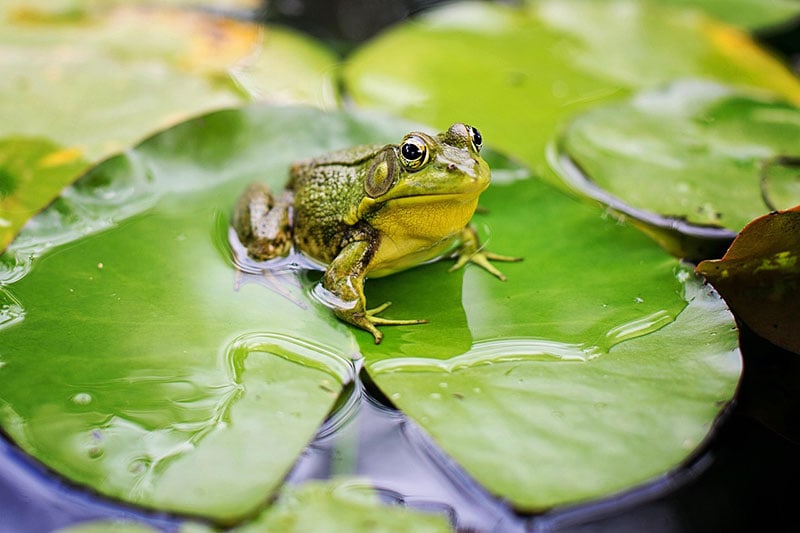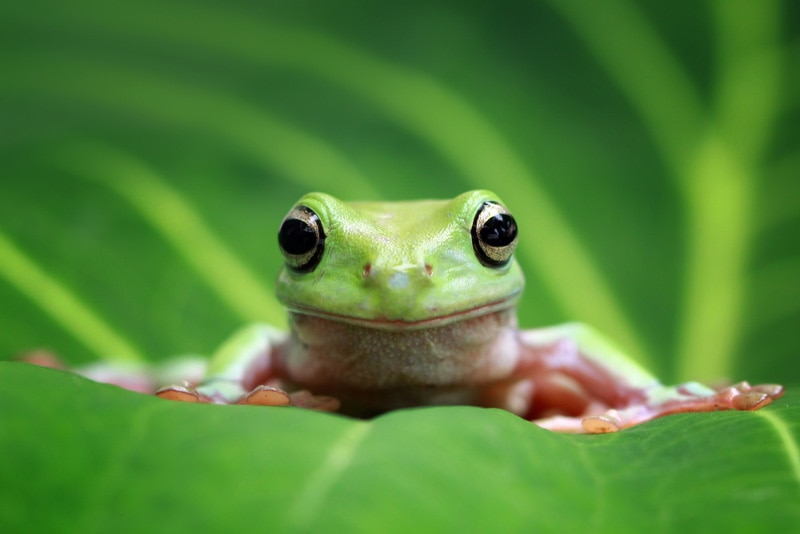How Long Do Pet Frogs Live? Average Lifespan, Data & Care
Updated on

Click to Skip Ahead
A pet frog’s lifespan varies a lot. Some pet frogs can live for up to 20 years, while others live for closer to 10. Generally, pet frogs live longer than their wild counterparts. However, they do require a proper habitat, diet, and healthcare for this to happen. Otherwise, they may live for shorter than their wild cousins.
Because there are so many factors involved, it can be hard to say exactly how long your frog might live without diving into these factors—that’s exactly what we’ll do below.
What is the Average Lifespan of a Pet Frog?

The average lifespan of a pet frog is between 10 and 20 years. However, some frog species live for much longer. For instance, Cane Toads can live for up to 40 years in captivity. Gray Tree Frogs only live for 7–9 years.
A frog’s species should be one of the first things you look at when determining how long your frog might live. Some frogs are a considerable commitment for years, while others don’t live nearly this long. Therefore, it’s important to understand the level of commitment you’re getting into before adopting a frog.
Here’s a list of common pet frog species and their average lifespan:
| American Bullfrog: | 16 years |
| American Green Tree Frog: | 6 years |
| Australian Tree Frog: | 16–20 years |
| Cane Toad: | 40 years |
| Common Frog: | 10 years |
| Goliath Frog: | 21 years |
| Gray Tree Frog: | 7–9 years |
| Green Frog: | 10 years |
| Northern Leopard Frog: | 9 years |
| Pacman Frog: | 6–10 years |
| Spring Peeper: | 6 years |
Why Do Some Pet Frogs Live Longer Than Others?
A frog’s lifespan can vary a lot for many different reasons. There is a lot you can do to keep your frog alive for as long as possible. However, some of these factors are out of your control.
1. Nutrition
Providing a balanced diet is essential for your frog’s needs. Different species have different dietary needs, so be sure you’re providing your frog with exactly what they need. Poor nutrition can lead to deficiencies and other health problems that can shorten your frog’s lifespan.
Often, a diverse diet is best, as it ensures your frog is consuming a range of different foods. However, the species of frog is very important when determining dietary needs.

2. Environmental Conditions
You need to provide your frog with a healthy habitat that mimics your frog’s natural environment. This will depend on the exact species, of course. Some frogs need different enclosure setups than others. The enclosure needs to be kept at the correct temperature and humidity with the proper lighting system. It’s a lot to set up, but it’s vital that you get it right.
3. Enclosure Size
Frogs need an enclosure that is plenty big enough for them. Otherwise, they may not get enough exercise or mental stimulation, leading to poor health. A larger enclosure is often recommended, as it provides your frog with plenty of room to explore.
You should typically avoid giving your frog a “minimum” enclosure. These are the minimum for your frog to survive—not thrive.
4. Size
The size of the frog can influence its lifespan. Larger frogs tend to live longer than smaller ones, as they are better able to defend themselves against predators and acquire food more easily. While this isn’t as big of a deal in captivity, the size of the frog still matters.
Generally speaking, larger frog species live longer than smaller ones.

5. Genes
The genes of the frog can influence its lifespan. Some frog species have longer lifespans than others due to their DNA and genetics. For example, Cane Toads can live up to 40 years in captivity, while common frogs can live up to 10 years.
Even within a species, differences can occur. Some frogs from quality breeders may live longer simply because their parents were more carefully chosen.
6. Breeding History
Frogs that are captive-bred tend to live longer than those from the wild. Those caught in the wild tend to have diseases and aren’t as adaptable. Therefore, they’re much more likely to die due to an underlying condition or just because they couldn’t adapt to captivity.
Luckily, whether or not a frog is bred doesn’t have much effect on their lifespan. Frogs don’t have much reproductive burden compared to mammals, as they lay eggs.
7. Healthcare
Frogs need healthcare, just like any other animal. If your frog is treated for diseases and parasites before they become serious, they’re much more likely to live longer. You should have your frog get regular checkups by a veterinarian and make them an appointment whenever you notice any strange symptoms.

The 4 Life Stages of a Pet Frog
Frogs have four main life stages. Here’s an overview of each one:
Egg

In the very beginning, frogs are eggs. Adult frogs often lay hundreds of eggs at a time, usually in vegetation in water. Exactly how they do this depends on the species. The eggs are surrounded by a jelly-like substance, which prevents them from drying out and protects them from predators.
Like all other eggs, the eggs also contain a yolk that provides nourishment for the baby frog as it develops. The development can take anywhere from 1 to 3 weeks, depending on the temperature and species.
Tadpole

After the frogs hatch, they are tadpoles. These baby frogs have gills and a long tail that’s utilized for swimming. They live solely in the water, where they feed on plant material and algae. The exact food they eat varies from species to species.
For the first couple of weeks, tadpoles don’t move very much as they absorb the remaining yolk from the egg. As this is used up, they must start looking for food. Tadpoles go through a lot of changes. Usually, you can watch their legs develop and their body lengthen as they look more and more like frogs.
Metamorphosis

Unlike other animals, tadpoles don’t suddenly turn into frogs. Instead, the process is elongated and can take some time. The majority of the changes will occur underwater. They will develop front legs, lungs, eyelids, and a tongue. Their gills and tail will slowly start to disappear.
During this process, the frogs may jump out of the water for a short time before disappearing back into the water. They will practice breathing air. Their diet will change, too, as they become carnivorous or omnivorous.
This whole process can take several weeks or several months, depending on the species.
Adult

Once the frog is done changing, it is officially an adult. The exact characteristics of the frog will depend on the species. However, most adult frogs must breathe air, will jump thanks to their strong back legs, and catch insects with their tongue. They often have moist skin, which helps them breathe.
After the breeding season, frogs will lay their eggs in a watery location like the one they were born at. Some frog species travel back to the exact same site to lay their eggs.
How to Tell Your Pet Frog’s Age
Telling the age of a pet frog is difficult—if not impossible. There isn’t an easy way to do it without harming the frog. If your frog is a tadpole, then you can somewhat guess what its age is. After the frog becomes an adult, it’s practically impossible.
The most accurate way to determine your pet frog’s age is by counting the rings in its bones. This method is called skeletochronology, and it is similar to counting the rings in a tree trunk. However, this method requires killing or injuring the frog by taking a sample of its toe or leg bone. Researchers often use this method for research, but it doesn’t make much sense for pet owners to use it.
You can sometimes tell based on a frog’s size. However, frogs can vary in size due to other factors, such as species and nutrition. Therefore, this method isn’t the most accurate.
Conclusion
The biggest determining factor in a frog’s lifespan is its species. Some species live a very long time, while others don’t live very long at all. Of course, this assumes the frog is taken care of. Frogs in poor environments or given subpar diets won’t live as long as others.
See Also:
- Toad Tadpoles vs Frog Tadpoles: The Differences (With Pictures)
- Is a Frog a Mammal? Differences & Facts
Featured Image Credit: Satoru Hatakeyama, Shutterstock












